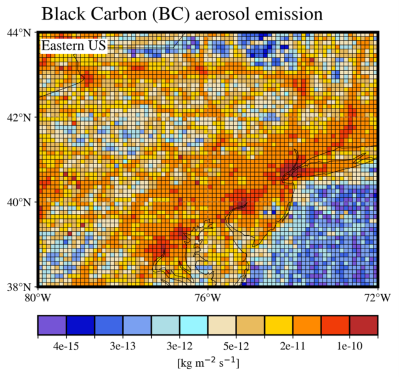More Accurate Aerosol Emission Needed for High-Resolution Earth system models
Anthropogenic emissions of aerosols and their precursors are often prescribed in global aerosol models. Most of these emissions are spatially heterogeneous at regional and local scales. When remapped from low-resolution data, the heterogeneity in emissions can be lost, leading to lower accuracy in the simulation. It can also cause a conservation problem if non-conservative remapping is used. The standard aerosol emission treatment in the Energy Exascale Earth System Model (E3SM) does not conserve mass and does not accurately represent the spatial heterogeneity of emissions, leading to significant errors in the simulation of aerosol sources, sinks, and their impacts on climate. Therefore, it is important to improve the emissions treatment, especially for future E3SM applications with regional refinement at high resolutions (e.g., at cloud-permitting scales).
Researchers introduced a revised emission treatment that conserves mass and preserves the original heterogeneity. They evaluated its impact on simulated aerosol properties and forcing estimates. They found that the revised emission treatment leads to improved heterogeneity in simulated surface concentrations, particularly in regions with sharp emission gradients. This is crucial for high-resolution or variable-resolution model applications where maintaining spatial heterogeneity in aerosol/precursor emissions is vital for accuracy. Their study shows the revised treatment consistently outperformed the original treatment, reducing the mean biases and improving the simulated variability in surface concentrations of carbonaceous aerosols.
This study highlights a new aerosol emission treatment with the potential to address the limitations of the original treatment for anthropogenic aerosol emissions in the E3SM atmosphere model, which can lead to significant errors in simulated aerosol properties and sources. The new emission treatment provides a solution to maintain spatial heterogeneity and mass conservation on the regionally refined grid, which is vital for future E3SM applications for studying aerosol-cloud interactions at convection-permitting scales. It also facilitates more accurate simulations of aerosol processes and their impacts on climate, which help improve the understanding and prediction of regional to local trends in anthropogenic aerosol effect.
In this study, the researchers improve the treatment of anthropogenic aerosol emissions in the Energy Exascale Earth System Model (E3SM) atmosphere model to better represent their spatial heterogeneity and conserve mass. They found that the original treatment used in low-resolution and regionally-refined high-resolution simulations leads to significant errors in the amount and distribution of aerosol emissions. This can have a significant impact on the simulated aerosol processes, particularly at high resolutions, and can affect the accuracy of model evaluations against observations. To address this issue, they revised the emission treatment to accurately preserve the original spatial heterogeneity and conserve mass. In the revised treatment, the emissions data are generated on model native grids offline using conservative remapping from high-resolution emission inventory. This retains the spatial heterogeneity and improves the simulation accuracy. The aerosol emission modules are also modified to allow the model to read data on either regular latitude-longitude or model-native spectral element grids. With this option, E3SM can bypass the online linear interpolation and the emission mass fluxes are conserved. The researchers found that the improved treatment leads to better representation of aerosol sources and sinks, and reduces errors in simulated aerosol mass concentrations and optical properties. This is crucial for accurately predicting the impacts of anthropogenic aerosols on regional and global climate.

